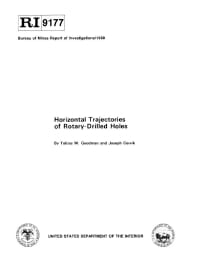Mining Publication: Horizontal Trajectories of Rotary-Drilled Holes
Original creation date: January 1988
Authors: TW Goodman, J Cervik
NIOSHTIC2 Number: 10006100
U.S. Department of the Interior, Bureau of Mines. Report of Investigations 9177, NTIS No. PB89-104087, 1988; :1-11
This Bureau of Mines report investigates the horizontal trajectory of boreholes drilled in coalbeds using the rotary drilling technique. Test holes drilled in coalbeds showed that the path of a borehole in the horizontal plane depends on drilling assembly configuration, drill bit rotation, and coalbed geologic features. An assembly that contained an 18-ft (5.5-M) long drill collar and two centralizers had the best horizontal stability evidenced by trajectories that deviated less than 16 ft (4.9 m) from a target at 1,000 ft (305 m). Removal of one of the centralizers resulted in a loss of control of hole trajectory in the horizontal plane. Generally, holes tended to turn to the right, presumably because of right-hand rotation of the bit. Deviations from the original bearing line were as much as 200 ft (61 m) or more at a depth of 1,000 ft (305 m).

NIOSHTIC2 Number: 10006100
U.S. Department of the Interior, Bureau of Mines. Report of Investigations 9177, NTIS No. PB89-104087, 1988; :1-11
- Cableless Electronic Surveying Systems for Horizontal Holes
- Coal Mine Methane: A Review of Capture and Utilization Practices with Benefits to Mining Safety and to Greenhouse Gas Reduction
- Comparison of Rotary and In-Hole Motor Techniques for Drilling Horizontal Boreholes in Coal
- Correlation of Sonic Travel Time to the Uniaxial Compressive Strength of U.S. Coal Measure Rocks
- Demonstration of Remote Mine Seal Construction
- Detecting Strata Fracturing and Roof Failures from a Borehole Based Microseismic System
- Effects of Stimulation Treatments on Coalbeds and Surrounding Strata: Evidence from Underground Observations
- Removing Methane (Degasification) from the Pocahontas No. 4 Coalbed in Southern West Virginia
- Rotary Drilling Holes in Coalbeds for Degasification
- Use of Vertical Boreholes for Assisting Ventilation of Longwall Gob Areas